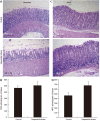Potential rat model of anxiety-like gastric hypersensitivity induced by sequential stress
- PMID: 29204059
- PMCID: PMC5698252
- DOI: 10.3748/wjg.v23.i42.7594
Potential rat model of anxiety-like gastric hypersensitivity induced by sequential stress
Abstract
Aim: To establish a rat model of anxiety-like gastric hypersensitivity (GHS) of functional dyspepsia (FD) induced by novel sequential stress.
Methods: Animal pups were divided into two groups from postnatal day 2: controls and the sequential-stress-treated. The sequential-stress-treated group received maternal separation and acute gastric irritation early in life and restraint stress in adulthood; controls were reared undisturbed with their mothers. Rats in both groups were followed to adulthood (8 wk) at which point the anxiety-like behaviors and visceromotor responses to gastric distention (20-100 mmHg) and gastric emptying were tested. Meanwhile, alterations in several anxiety-related brain-stomach modulators including 5-hydroxytryptamine (5-HT), γ-aminobutyric acid (GABA), brain-derived neurotrophic factor (BDNF) and nesfatin-1 in the rat hippocampus, plasma and gastric fundus and the 5-HT1A receptor (5-HT1AR) in the hippocampal CA1 subfield and the mucosa of the gastric fundus were examined.
Results: Sequential-stress-treated rats simultaneously demonstrated anxiety-like behaviors and GHS in dose-dependent manner compared with the control group. Although rats in both groups consumed similar amount of solid food, the rate of gastric emptying was lower in the sequential-stress-treated rats than in the control group. Sequential stress significantly decreased the levels of 5-HT (51.91 ± 1.88 vs 104.21 ± 2.88, P < 0.01), GABA (2.38 ± 0.16 vs 5.01 ± 0.13, P < 0.01) and BDNF (304.40 ± 10.16 vs 698.17 ± 27.91, P < 0.01) in the hippocampus but increased the content of nesfatin-1 (1961.38 ± 56.89 vs 1007.50 ± 33.05, P < 0.01) in the same site; significantly decreased the levels of 5-HT (47.82 ± 2.29 vs 89.45 ± 2.61, P < 0.01) and BDNF (257.05 ± 12.89 vs 536.71 ± 20.73, P < 0.01) in the plasma but increased the content of nesfatin-1 in it (1391.75 ± 42.77 vs 737.88 ± 33.15, P < 0.01); significantly decreased the levels of 5-HT (41.15 ± 1.81 vs 89.17 ± 2.31, P < 0.01) and BDNF (226.49 ± 12.10 vs 551.36 ± 16.47, P < 0.01) in the gastric fundus but increased the content of nesfatin-1 in the same site (1534.75 ± 38.52 vs 819.63 ± 38.04, P < 0.01). The expressions of 5-HT1AR in the hippocampal CA1 subfield and the mucosa of the gastric fundus were down-regulated measured by IHC (Optical Density value: Hippocampus 15253.50 ± 760.35 vs 21149.75 ± 834.13; gastric fundus 15865.25 ± 521.24 vs 23865.75 ± 1868.60; P < 0.05, respectively) and WB (0.38 ± 0.01 vs 0.57 ± 0.03, P < 0.01) (n = 8 in each group).
Conclusion: Sequential stress could induce a potential rat model of anxiety-like GHS of FD, which could be used to research the mechanisms of this intractable disease.
Keywords: 5-hydroxytryptamine; Anxiety; Brain-derived neurotrophic factor; Functional dyspepsia; Gastric hypersensitivity; Nesfatin-1; Rat model; γ-aminobutyric acid.
Conflict of interest statement
Conflict-of-interest statement: All authors declare that there are no conflicts of interest.
Figures










Similar articles
-
Enhanced sympathetic nerve activity induced by neonatal colon inflammation induces gastric hypersensitivity and anxiety-like behavior in adult rats.Am J Physiol Gastrointest Liver Physiol. 2016 Jul 1;311(1):G32-9. doi: 10.1152/ajpgi.00067.2016. Epub 2016 May 5. Am J Physiol Gastrointest Liver Physiol. 2016. PMID: 27151940 Free PMC article.
-
Novel sequential stress model for functional dyspepsia: Efficacy of the herbal preparation STW5.Phytomedicine. 2015 May 15;22(5):588-95. doi: 10.1016/j.phymed.2015.03.012. Epub 2015 Mar 27. Phytomedicine. 2015. PMID: 25981926
-
A rat model of chronic gastric sensorimotor dysfunction resulting from transient neonatal gastric irritation.Gastroenterology. 2008 Jun;134(7):2070-9. doi: 10.1053/j.gastro.2008.02.093. Epub 2008 Mar 8. Gastroenterology. 2008. PMID: 18448102
-
Developmental origins of functional dyspepsia-like gastric hypersensitivity in rats.Gastroenterology. 2013 Mar;144(3):570-579.e3. doi: 10.1053/j.gastro.2012.11.001. Epub 2012 Nov 8. Gastroenterology. 2013. PMID: 23142231 Free PMC article.
-
Stress and psychologic and environmental factors in functional dyspepsia.Scand J Gastroenterol Suppl. 1991;182:40-6. doi: 10.3109/00365529109109536. Scand J Gastroenterol Suppl. 1991. PMID: 1896829 Review.
Cited by
-
[Association between functional dyspepsia and serum levels of brain-gut peptides in children].Zhongguo Dang Dai Er Ke Za Zhi. 2022 Apr 15;24(4):387-391. doi: 10.7499/j.issn.1008-8830.2112029. Zhongguo Dang Dai Er Ke Za Zhi. 2022. PMID: 35527413 Free PMC article. Chinese.
-
New Aspects of Corpus Luteum Regulation in Physiological and Pathological Conditions: Involvement of Adipokines and Neuropeptides.Cells. 2022 Mar 10;11(6):957. doi: 10.3390/cells11060957. Cells. 2022. PMID: 35326408 Free PMC article. Review.
-
Phoenixin-A Pleiotropic Gut-Brain Peptide.Int J Mol Sci. 2018 Jun 11;19(6):1726. doi: 10.3390/ijms19061726. Int J Mol Sci. 2018. PMID: 29891773 Free PMC article. Review.
-
Suppressive action of nesfatin-1 and nesfatin-1-like peptide on cortisol synthesis in human adrenal cortex cells.Sci Rep. 2024 Feb 17;14(1):3985. doi: 10.1038/s41598-024-54758-7. Sci Rep. 2024. PMID: 38368491 Free PMC article.
-
Meal-Sensing Signaling Pathways in Functional Dyspepsia.Front Syst Neurosci. 2018 Apr 5;12:10. doi: 10.3389/fnsys.2018.00010. eCollection 2018. Front Syst Neurosci. 2018. PMID: 29674959 Free PMC article. Review.
References
-
- Tack J, Caenepeel P, Fischler B, Piessevaux H, Janssens J. Symptoms associated with hypersensitivity to gastric distention in functional dyspepsia. Gastroenterology. 2001;121:526–535. - PubMed
-
- Tack J, Talley NJ, Camilleri M, Holtmann G, Hu P, Malagelada JR, Stanghellini V. Functional gastroduodenal disorders. Gastroenterology. 2006;130:1466–1479. - PubMed
-
- Van Oudenhove L, Vandenberghe J, Geeraerts B, Vos R, Persoons P, Fischler B, Demyttenaere K, Tack J. Determinants of symptoms in functional dyspepsia: gastric sensorimotor function, psychosocial factors or somatisation? Gut. 2008;57:1666–1673. - PubMed
MeSH terms
LinkOut - more resources
Full Text Sources
Other Literature Sources
Medical
Miscellaneous

